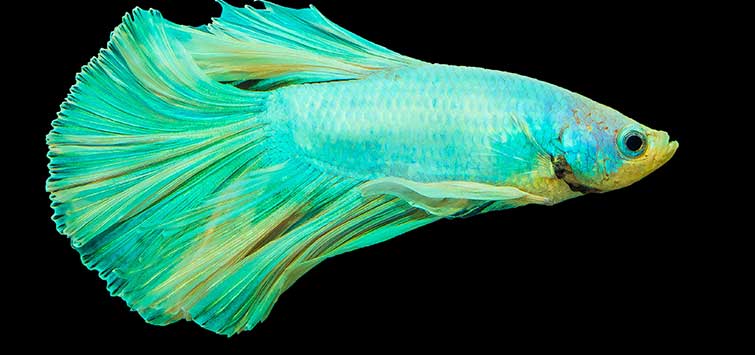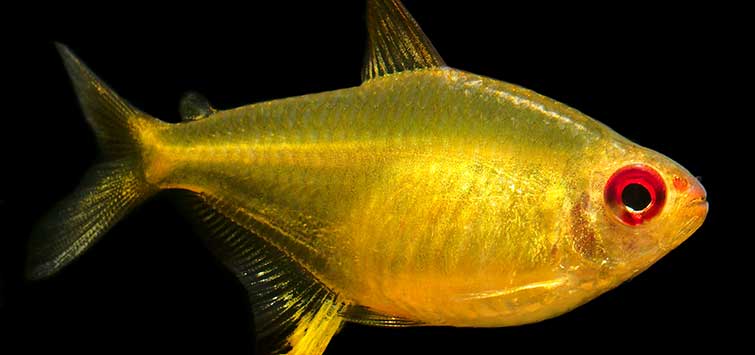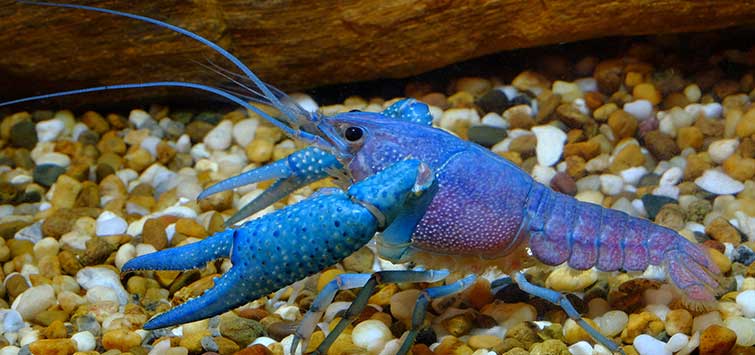Adding Color to the Freshwater Aquarium: Going Green
Author: Phil Purser
Plants are famous for their ability to add a serene, verdant look to an aquarium, but what if you don’t have a planted tank? One expert hobbyist provides a number of fish that will add a green sparkle to the aquarium.
The Greatness of Green
Green, one of the rarest colors in the hobby, is highly sought after and a true gem to behold. Both hobbyists and aquaculturists know this, so the race to selectively breed, farm, and import green specimens has been the focus of many industry insiders for decades.
The ultra-rare green betta wears a dark mantle that shimmers. The spectacular green fancy guppy, likewise, is clad in a metallic coat that catches the eye—and breath—of the hobbyist with its wondrous, emerald sheen.
Best Green Freshwater Fish
Not all greens are the result of selective aquaculture, however. There are green cory catfish, green cichlids, and green puffers. Because green is a rare color in the aquarium, I’ve chosen to offer within this article as wide a diversity of aquarium species as possible. I will cover some peace-loving community tropicals that can thrive in a wide range of home aquarium environments, as well as some more advanced, semi-aggressive species. So, with as many shades and hues and species to survey in one article, let’s not waste any more time. Let’s go green!
Emerald Cory
We begin our green quest at the bottommost reaches of the freshwater environment with some cory cats. The first is the emerald cory (Brochis splendens), which thrives in the warm, soft waters of the Upper Amazon River Basin. A stout little catfish that grows to lengths of just over 3 inches, this fish wears overlapping, shingle-like scales that are, as its name suggests, emerald in coloration. The hard, metallic sheen of this catfish only adds to its beauty. Under certain slants of light, this fish may take on a bluish green shimmer. Fins are pale green to almost fully translucent. Females are the larger of the two sexes; sexual dichromatism is evident in that males have pale or yellowish bellies, while females tend toward a pink-tinted belly.
In the wild, this fish thrives in slow-moving waters that are heavily choked with vegetative matter. In the home aquarium, this need for heavy vegetative cover remains. The emerald catfish does best when housed in tanks outfitted with mosses, ferns, and sword-leaved plants. While it is not necessarily a schooling species, the emerald catfish is best kept in threes or fours, as a lone individual can be extremely shy and retiring in the home aquarium. Without others of its kind around, this fish stresses.
Active bottom-feeders that “police-up” (as my late father used to say of our emerald cory in the aquarium of my childhood), or scavenge, fallen flakes on the floor of your tank, these catfish perform a valuable service in the tank because they are such efficient bottom feeders. Bloodworms are, however, favored by these catfish. Know that this fish does need to be specifically fed, not just left to rely on the leftovers of others.
As if all those attributes are not enough, the emerald cory is an exceedingly peaceful species. Neither a chaser nor a fin nipper, this fish simply will not pester anything in your aquarium. Naturally nocturnal, the emerald cory hides during the day, so caves, upturned flower pots, or hideaways are necessary. Maintain the emerald cory catfish at 6.0 to 8.0 pH, 3.0 to 20.0 water hardness, and temperatures of 72°to 81°F. The emerald cory catfish is a wonderful mix of aesthetic beauty and practical utility in the home aquarium.
Green Gold Catfish
Cousin to the emerald catfish is the green gold catfish (Corydoras melanotaenia). Native to the warm waters of the Rio Meta Basin in Colombia, this little catfish is a true jewel of the freshwater aquarium. Growing to just over 2 inches, this demure catfish thrives in soft to medium hard water of 2.0 to 18.0 kH, pH of 6.2 to 7.8, and temperatures of 72° to 78°F. Native habitats are much like those described for the emerald cory catfish.
Given enough vegetative cover and hiding places, these fish thrive in virtually all community aquarium environments. They are peaceful and pose no threat to any other adequately sized species. Wearing dorsal coats of metallic green accented with a gold to bronze sheen, these fish sport translucently golden dorsal, pectoral, and caudal fins. A rouge blush exists behind the gill covers of particularly handsome specimens.
Devout bottom feeders that do an excellent job of cleaning the lower reaches of the tank, these fish are both beautiful and practical additions to the home aquarium. In the wild, these fish prey upon benthic crustaceans, invertebrates, insect larvae, fish fry, and both fish and amphibian eggs. Thus, a high-protein diet in the home aquarium is recommended, and like their emerald cousins, they too need to be specifically fed. Augment sunken flakes with shrimp pellets or protein-enhanced catfish pellets. In my mind, there are no disadvantages to adding either of these species of green cory catfish to your aquarium.
Green Bettas
At the very top of the water column lives one of the most famous freshwater fish: the betta. Bettas are native to warm, shallow backwaters and rice fields. The females of the species are relatively dull in coloration and have shorter, more rigid fins, while the selectively bred males wear vibrantly colored hues and bear the graceful, flowing fins that have become the hallmark of the species.
When I was a child, bettas came in two varieties: red and blue. Now, three decades later, there are wide varieties of color-cultivated bettas on the market, including two types of green bettas.
Renowned for their elaborate finnage and flashy coloration, these fish have been the target of intense selective breeding for decades. One of the rarest and most sought-after color morphs, the green variety exists as either the “bluish” type or the “blackish” type. Many betta purists dismiss the “bluish” type of betta because, under some lights, it has a turquoise sheen to it. The general aquarium hobbyist, however, will instantly see the inherent beauty in this metallic-green animal. The second, and perhaps more desirable, color variant is the “blackish” type. Appearing solid black at a distance or when viewed under poor lighting conditions, this fish is, in fact, a rich hunter green. This type’s full beauty can be appreciated only under direct, intense lighting. The dark-green hues of this betta, seemingly alive under the metallic sheen of the body scales, burn with the cold, mineral fire of an uncut emerald glinting in the sunlight.
Should one of the green wonders catch your eye, you should know a few things before taking the plunge. Bettas are top-level swimmers that thrive best under ample surface vegetative cover. If you house a green betta in a tank without any, you may notice your fish clinging to the wall of your tank. Prevent this behavior (and the accompanying stress to your fish) by adding some floating plants to your tank. I recommend water lettuce or water hyacinth for this. Not only do these plants look good and provide ample vegetative cover, but their root systems do a spectacular job of filtering the water column.
Bettas enjoy warmer waters than most tropical fish. I recommend keeping them at temperatures between 75° and 83°F. Bettas are adaptable in terms of the pH they can withstand and may be acclimated to live within a range of 6.0 to 8.0. Bettas prefer soft to moderate water hardness.
Bettas can be very territorial of their upper-level domain and are not shy about defending it, so these fish do not mix well with other top-level swimmers. Likewise, fish with very elaborate finnage (veil-tailed goldfish, sailfin mollies, skirted tetras) may find themselves the target of betta aggression. Of course, the betta is not always the aggressor; fin-nipping species may zero in on the gossamer finnage of your green betta and take more than a few bites. Because bettas are relatively slow swimmers, they can put up little defense against nimble fin nippers. Given the proper water chemistry and ample top-level vegetation, a green betta can add just the sparkle you desire for your home aquarium.
Green Terror Cichlid
For all of you South American cichlid lovers out there, the color green may have just the species you’ve been looking for: the green terror cichlid. While some cichlid hobbyists will claim that this animal’s common moniker is a misnomer (the word “terror” does this semi-aggressive species a terrible injustice and decreases its popularity in the pet trade), others will say that this species’ common name doesn’t even come close to describing this violent, green-flecked nightmare!
Native to the RÍo Tumbes in Peru and the RÍo Esmeraldas in Ecuador, the green terror may reach lengths of nearly 12 inches in the wild. Physiologically, the green terror is a thick-bodied fish with a pronounced forehead and gaping jaws. The dorsal fin is very long, as is typical of the cichlids, and the caudal fin is correspondingly broad (the muscular caudal peduncle aids in adding prolonged bursts of speed when the green terror is hunting). Basal coloration is olive, and the head, lower jaw, and body are flecked with electric green marbling. In particularly handsome specimens, the caudal, dorsal, and anal fins will also be marbled in iridescent green.
Maintain your green terror in moderate to hard water of 15.0 to 25.0 kH, with an alkaline pH of 7.1 to 8.0 and relatively cool temperatures ranging from 64° to 74°. I do not recommend housing the green terror cichlid in a tank of less than 90 gallons. A tank of this size should assure a long-term habitat of ample size for this fish.
As for tankmates, this bruiser can mix well with few species. Oscars (Astronotus ocellatus), Midas cichlids (Amphilophus citrinellus), Jack Dempseys (Rocio octofasciata), and firemouth cichlids (Thorichthys meeki) all make acceptable tankmates, provided that the size of all fish is appropriate (one cichlid that is smaller than the diameter of another cichlid’s mouth will end up as a meal to that cichlid!). Two species to avoid mixing with the green terror are the wolf cichlid (Parachromis dovii) and the jaguar cichlid (P. managuensis). As juveniles, these three fish may coexist peacefully, but with maturity comes a near instinctual rivalry that almost always ends in violence.
Tankmates aside, the green terror is one of the most hardy and least demanding of the cichlids. Able to thrive under a wide range of water conditions, this stalwart fish is a favorite of beginning cichlid fans. Enthusiastic eaters, green terrors will devour virtually all fare offered—juveniles take cichlid pellets, brine shrimp, krill, and bloodworms but quickly graduate to earthworms, crickets, etc. Some hobbyists report that the more varied this fish’s diet is, the more bold and garish its coloration becomes.
Spotted Congo Puffer
If you are anything like me, you have a taste for the occasional aquarium oddity. You know, those fish that don’t seem to fit any normal classification but whose uniqueness and alien appearance make them just too tempting to pass up. Well, if that sounds like your cup of tea, I’ve got just the emerald-hued species for you: the spotted Congo puffer (Tetraodon schoutedeni).
The spotted Congo puffer is one of the very few species of fully freshwater puffers known to exist in the world. Taking its common name from its dorsal coloration of dark spots atop a bright, semi-iridescent green base, this species also has green fins and a light-green to pale-white or ivory-colored ventral surface. Often confused with T. fluviatilis, a brackish species, or T. nigroviridis, a semi-brackish species (and very aggressive toward virtually all possible tankmates), the spotted Congo puffer is a docile species that can be mixed with a wide variety of tropical species.
Naturally occurring in the Congo River, this fish thrives in water conditions of 6.2 to 7.3 pH and temperatures of 71° to 78°. These fish also tend to fare better in heavily planted tanks that have an appropriate amount of aquarium salt added (I recommend 1 tablespoon per 5 gallons). In the wild, the spotted Congo puffer feeds on benthic insect larvae, crustaceans, and small fish and amphibians. In the home aquarium, it will thrive on frozen/pellet food, krill, brine, bloodworms, etc. Small snails will also be eagerly taken.
When it comes to tankmates, this small (growing to adult lengths of just over 3 inches) puffer can thrive best with moderately sized species that share its water chemistry requirements: larger mollies, platies, guppies, and swordtails are good choices, as are salt-tolerant catfish species and other central African tropicals, such as the Congo tetra (Phenacogrammus interruptus). Be aware that these fish like subdued lighting, so plenty of driftwood gnarls and floating plants (which will help maintain superior water quality) are recommended for providing sufficient cover for this species.
One of the only drawbacks to owning the spotted Congo pufferfish is the widespread confusion that frequently accompanies this species at the point of purchase. This fish looks very similar to both T. fluviatilis and T. nigroviridis, which wear a bright-green basal color topped with lots of black or dark, chocolate-brown freckles. Both of the mimic species are highly aggressive and require very different water conditions. Likewise, they also grow much larger than T. schoutedeni. Owing to their need for brackish water conditions, these similar-looking species would not likely survive long in your tank.
As a general rule, all species of puffer are sloppy eaters, and wasted food items can lead to ammonia/nitrogenous waste spikes very rapidly. Depending on the efficiency and magnitude of your tank’s filtration system, therefore, 20 to 50 percent water changes are recommended weekly. Likewise, this species does not mix well with any type of invertebrate (it may attack and maul snails or crayfish too big to fit fully in its mouth) and may swallow any small fish (rasboras, etc.) whole. If mixed with appropriate species, however, the spotted Congo puffer is a definite conversation starter, and I highly recommend it.
Other Green Accents
As is true of all the articles in this series, there is simply not enough room to discuss all the green species available in the hobby today. Designer species of barbs, such as the green tiger barb, can add a deep swath of dark green to your tank. Likewise, some of the platies of the family Poeciliidae have been selectively cultivated to have greenish to black accents on their otherwise red bodies. So keep searching, keep researching, and keep adding your favorite color to your home aquarium. Finding the right species that will both add the colors you desire and mix well with your existing species can be daunting, but don’t give up the quest!




